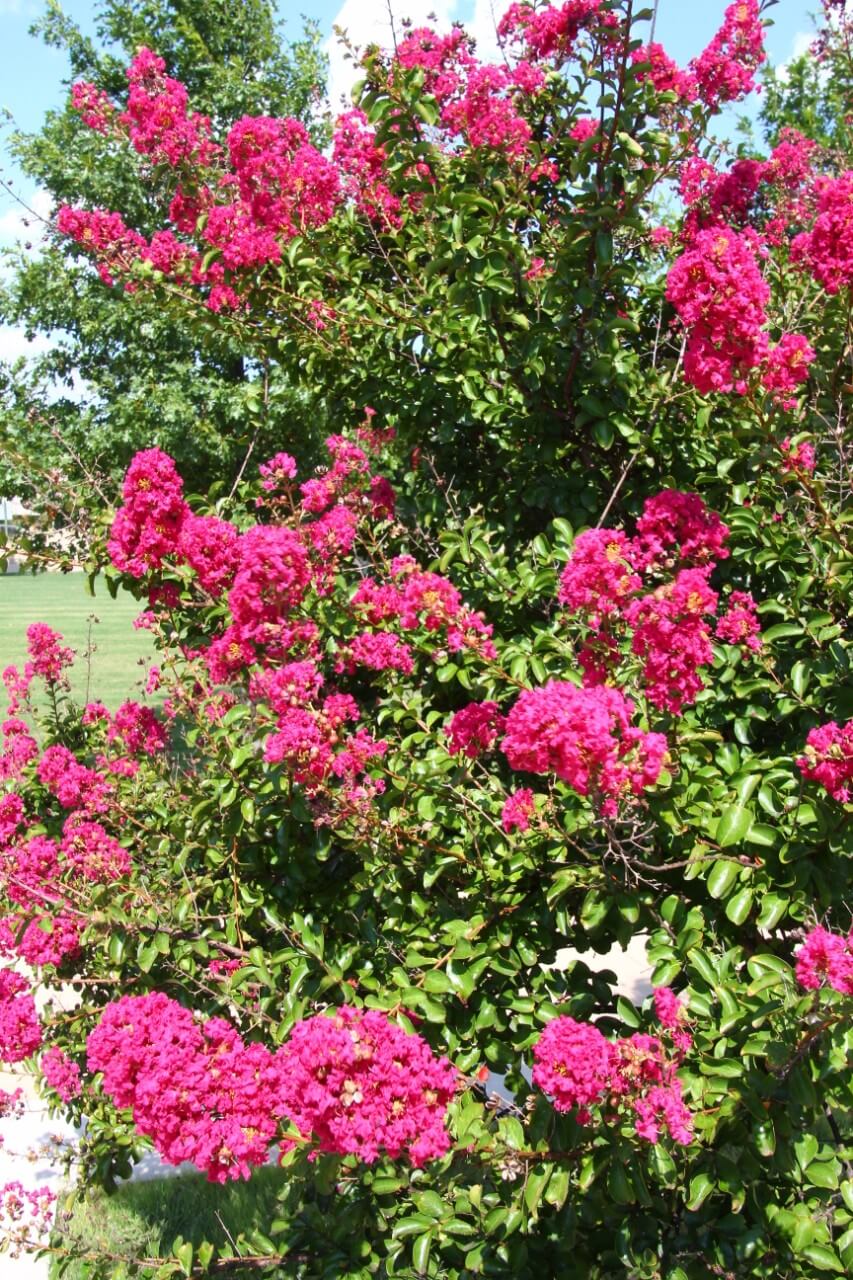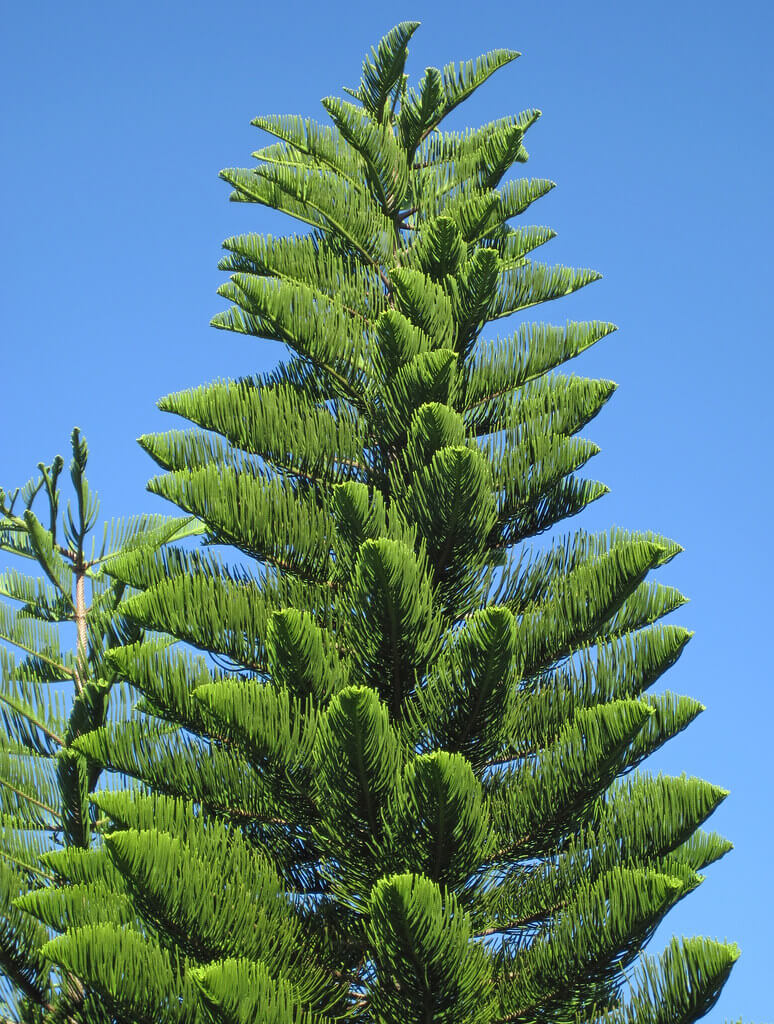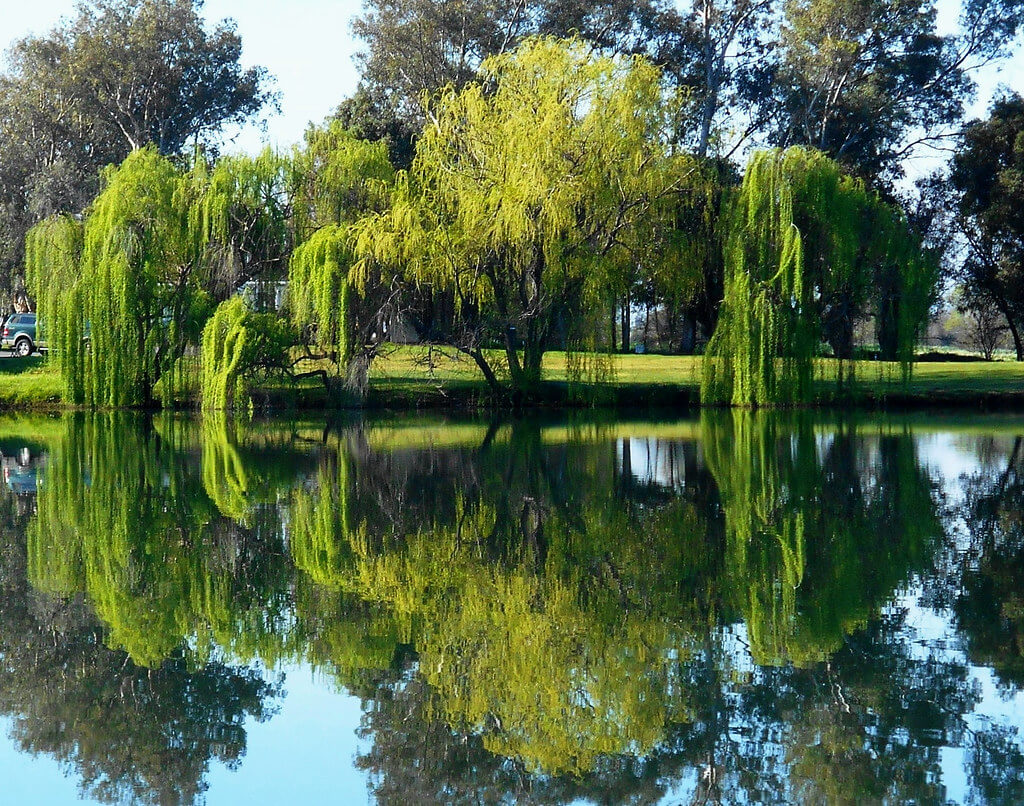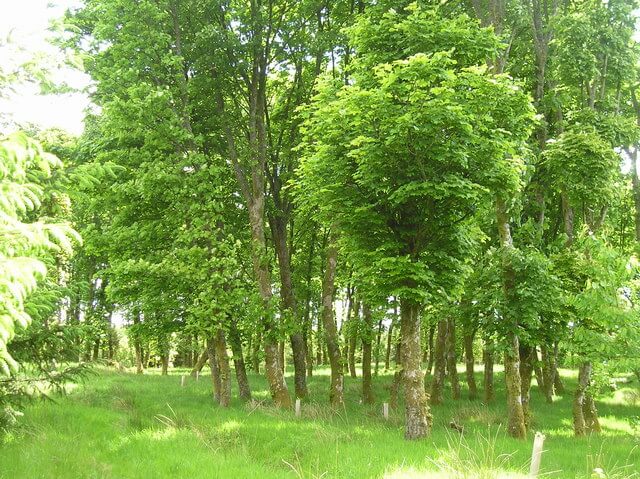There are thousands of different tree species in the world, but they can be categorized into several types.
Here are the types of trees and their distinctive features.
Category of trees
1. Coniferous trees
In common terms, this category would refer to evergreens. This means that the foliage of these types of trees will remain green all year round.
Their most distinct characteristic is their needle-like leaves. Coniferous trees would be the likes of pines, cedars and Christmas trees.
2. Deciduous trees
This category refers to hardwoods. Their most common characteristic is annual foliage shedding during fall. Hardwoods have more varieties to note.
They have unique appearances and characteristics particularly in terms of shapes of leaves.
Related: Trees With White Flowers | Trees With Purple Flowers
Popular Types of trees


1. Ash trees (Fraxinus)

It is one of the most preferred landscaping trees in North America and is a part of the olive family. It has more or less than 60 species and the most popular of them are black, green and white ash.
They are drought tolerant and hardy being able to retain their foliage all year long. Its leaves will turn yellow and burgundy during fall. Females produce winged fruits while males don’t. Diamond-shaped ridges will appear in the bark when they reach maturity.
2. Aspen trees

It is considered as the most widespread tree in North America. It is distinguishable for its tube-like overall appearance, white, soft trunks and yellow foliage in the fall.
A group of aspens is called a clone because each one is the exact genetic replica of another making them stand out for their generic appearance.
It has one of the most prolific and extensive rooting rates even after it is chopped down, it would be hard to extinguish the tree altogether.
3. Birch trees

Interesting fact, these trees were the first types of trees to emerge right after the glaciers of the ice age receded.
They belong to the genus Betula with more than 50 species (18 of which could be found in North America alone). They have distinguishable papery white bark with irregular shaped black-brown furrows.
They are considered as rare deciduous that are popular in winter landscapes. However, they cannot live long compared to hardwoods as they could only last for 20 years but not for 100 years.
4. Cedar trees (Cedrus)

These trees are popular winter trees because they are used as Christmas trees. As wide and high growing evergreens, they are commonly found in streets, parks, wide gardens and boulevards.
It is native to the Himalayas and around the Mediterranean. In the US, it is grown as an ornamental because there are no native species available in the country. They retain their green foliage year-round and have a distinct holidays spice scent.
5. Cherry trees

These trees typically last for only 20 years except for the black cherry which lasts for up to 250 years. It is commonly associated with spring as its first blooms appear in the first week of spring.
A lot of spring events are dedicated to it especially in the US and Japan. Some cherry trees produce edible fruits while others are grown solely as ornamentals like the cherry blossoms.
Nonetheless, all cherry blossoms are edible and are dried for tea. They can grow huge (up to 80ft in the wild) and their black-brown trunks are sturdy.
Related: Types of Cherry Trees
6. Conifer trees

It is one of the largest groups of gymnosperms in all continents except Antarctica with more than 800 species. They don’t produce flowers and fruits.
It is one of the tallest growing trees and includes the Giant Sequoias of North America. They are economically valuable as they produce a steady supply of good quality timber and in paper production.
7. Cottonwood trees (Populus deltoids)

It is a large deciduous tree that is strikingly fast-growing but with shorter lifespan. It is native to Canada, Mexico and the US.
It niches alongside streams and lakes but can be cultivated anywhere in high altitude places. It has smooth, yellow green bark that will turn ash gray when mature.
It has long, triangular leaves that are toothed in the edge. It is considered as an ornamental tree but it is also used to manufacture boxes.
Related: Types of poplar trees
8. Crabapple trees

Any apple tree that produces fruits with 2-inches in diameter is considered as a crabapple.
It produces a multicolor façade in the summer with its dark-colored buds and lively colored flowers. Its leaves are dark green in the summer and spring and turn to red, bronze, yellow and purple in the fall.
Its fruits are used in tarts, jams, ciders and other preserves. It is native to Asia, particularly in Kazakhstan and has existed for 6,000 years.
9. Crepe myrtles trees (Lagerstroemia)

These trees provide an exquisite show year-long with their deep green foliage, large crepe-like blooms in hues of white, lavender and pink and slender, green-brown trunk.
They can be cultivated as garden shrubs in gardens but full-blown trees are usually seen in parks and streets.
The more sun it receives, the more blooms it will produce. It is drought-tolerant and can thrive in a wide range of growing conditions.
10. Cypress trees

The cypress is one of the most famous ornamental evergreen as it is also used as an alternative Christmas tree for a winter landscape.
Most cypresses look like open umbrellas including the Monterey cypress which grows at 70ft tall. Christmas cypress would include the Arizona cypress while the smallest growing cypress is the Gowen cypress.
It has green-blue leaves that overlap like braids. The most popular is the Lone cypress covering a 17-mile drive in California.
11. Dogwood trees

They may be small-sized ornamentals but aesthetically, they will never disappoint. It produces masses of tiny, white/yellow flowers in spring contrasting in an acid gray-brown bark.
Because its wood is coarse and hard, it is also used in the production of tool handles, golf club heads, butchers’ blocks, mallets and jewelry boxes.
12. Elm trees

This semi-deciduous/deciduous tree is found deep in forests around the world. This tree is native to Europe and Asia and there are more than 40 genus of elms around the world.
The most famous of these would be the American, English and Slippery elm. Its leaves are yellow green but will turn darker as they mature.
Its leaves are notable for having a rough underside. It also has unique gray bark with odd furrows in it. As it grows older, the bark will flake and inside it will be white and brown wood. It is used to make boxes, crates and barrels.
Related: Types of elm trees
13. Ficus trees

They are also called the weeping fig and are known for their glossy, deep green foliage. They are also notable for their longevity either as houseplant or in the wild.
They have minimum care requirements and are low growers making them easy to naturalize in home gardens.
Its most popular species are Midnight known for their curly and dark leaves, the Starlight with deep green leaves with white edges and Judith with deep green leaves and yellow edges.
14. Fig trees

These trees are known to thrive in warmer climates. They grow delectable fruits with nutty taste, significantly referenced in the Judeo-Christian traditions.
Despite being known to grow in long summers, they can also be kept as indoor plants in temperate and colder regions.
Its most popular species is the common fig especially for new homeowners as they do not need pollinators to facilitate growth.
Other fig cultivars are harder to grow since they need specific pollinators which are wasps. Its fruits are preserved and are used as ingredients for cooking.
Related: 17 Best Plants That Repel Wasps And Bees
15. Fir trees

Fir trees are very popular in North America because they are commercially sold as Christmas trees.
There are more than 55 species of this tree but the famous species are the Balsam and Fraser fir. No fir tree could be grown as shrubs. At mature phase, they can reach a height of up to 260ft and their trunks could reach 13ft in diameter.
They have a pyramid shape appearance and they are distinguished from pines for their winged seeds and erect cones.
16. Flowering trees

As the name implies, this type of trees refer to trees or shrubs that either bloom with flowers only (ornamentals) or will bloom flowers that will turn into fruits after (fruit-bearing, flowering trees).
Flowering trees that will bloom year-round would be Dogwoods, Redbuds, Cherries and Fringes. Forsythia, magnolias and flowering crabapples are also included in the list of flowering trees.
17. Fruit trees

Various fruit trees could thrive in various conditions but most of them will survive in temperate climates from zones 5-7.
All fruit trees are considered flowering trees too because their flowers will turn into fruits as they mature. But it has to be clarified that fruit trees are limited to trees that bear fruits for human consumption.
Once all the growing conditions are established, it will continue to bear fruits in the years to come and shall require minimum care conditions.
18. Hardwood trees

The term hardwood botanically refers to trees but astoundingly with no similar characteristics. Instead of needle-like leaves, hardwoods have large leaves.
They are also distinguishable because they produce fruits that are most of the time referred to as nuts.
Most importantly, they grow dormant during the winter and come back when temperatures stabilize. It is interesting to note that 40% of all trees in North America are considered hardwoods.
19. Hawthorn trees

They may be small in size but Hawthorn trees form a large group distinguished through their fruits and flowers.
All Hawthorn trees have recognizable scaly brown or gray barks and small, simple leaves. It is mostly used as a shrub in landscaping and for other commercial uses.
20. Hickory trees

These trees are exotic looking, with sturdy, dark brown trunks found in lines in state parks and large gardens. It is divided into two major divisions: common/true hickories or pecan hickories.
The pecan hickory is the sole species in this group that have commercial value because it produces good timber. All hickories have distinct oblong-shaped leaves that will change from deep green into yellow during fall.
They have gray-brown barks that peel as they mature. They are also known for their longevity as they could reach 300 years of age.
Related: Types of Hickory Trees
21. Juniper trees

These trees thrive in arid regions and are considered as one of the most common trees around the world with almost 70 species.
The common juniper, to be specific, is the only species that lives in both North America and Europe. Junipers have two types of leaves: awl-like and scale-like.
Most bear two types of leaves while some features only one type of leaf. Because they produce small tree rings, they are valuable for timber production. They are also known for their longevity. Rocky Mountain junipers are documented to have existed from 2,000 years ago.
22. Lilac trees

Lilacs can be cultivated as either shrub or tree and can be further divided between upright lilacs and densely branched lilacs.
Upright lilacs are also called common lilacs and are known for their wide color selection and fragrance types.
On the other hand, densely branched lilacs are specifically bred because they bloom in masses in cramped up spaces. The most popular densely branched lilacs are the Manchurian and Meyer lilac.
23. Lime trees

This type has more than 80 cultivars and hybrids in its cluster. They are popular trees because they produce edible, sweet, acidic fruits.
Its most popular species is the Mexican lime because of its economic value. It is used in culinary purposes and common in the beverage and confectionery industry.
Its peels are also processed and dried for many functions in Asia and the Americas. In terms of appearance, they often share irregularly branching twigs, small, glossy leaves and thorns in their stems.
24. Locust trees

This type comes from the pea family and can be grown through shrubs and trees. All species of locusts are native to all regions in North America and are cultivated for many functional reasons including erosion control and for garden hedging.
Because of their white, cascading flowers, they are also cultivated as ornamentals. The most popular locust is the black locust tree.
25. Mahogany trees

This medium-size evergreen has small pointy leaves and hard fruits. It is native to southeast Asia, the Caribbean and south Florida.
It has a sturdy, thin trunk and gray bark that will turn darker as it gets old. It is one of the most popular industrial trees because of its rich brown color.
It is used to manufacture musical instruments, boats, caskets and furniture. Its bark is also scrubbed for its potency as astringent.
26. Mango trees

Mangoes are famous tropical trees since below 30 degrees could already damage the tree itself and its fruits.
It can grow very tall at 100ft and can provide a wide foliage canopy at 35ft. It is long, pointy, leathery leaves and small, yellow flowers emitting a sweet aroma before producing fruits.
Mangoes receiving enough light will have red stems while those with less than 6hours of light everyday will have brown-black barks.
27. Maple trees

It is dubbed as the most important North American forest tree group. They are known for being valuable woods in wildlife conservation and as highly aesthetic forest trees.
Its most popular species is the sugar maple as it is the source of maple syrup. The bark color depends on the maple tree type but its most distinguishable feature would be its twig, bud and leaf arrangement and color.
28. Mulberry trees

These trees have gained popularity through the years because of their ornamental value and fleshy, edible fruits that are added to tarts, pies and fermented as wine.
But since they are favorites of insects, butterflies and even pests, they are extinguished because of these pesky guests and because they also tend to become invasive.
The most famous mulberries are the black and red species.
29. Oak trees

These trees are found almost everywhere in New York City. There are at least 300 known oak species and 55 of them come from North America.
Oaks are divided between black and white oaks. White oaks have sweet tasting acorns while black oaks have bitter acorns and bristled leaves. They niche in forests and valleys.
30. Palm trees

This is another tropical tree with more than 2600 species. It is also one of the most planted trees because of their immanent benefits from food products, wood supply, oil, fuel and more.
They are also very common in parks, coastal boulevards and hotels but in regions that do not experience frost. Palm trees are also symbolic in many cultures and traditions.
Related:
- Types of palm trees in Florida
- How much do palm trees cost?
- Pygmy Date Palm (Phoenix roebelenii) Care
- Chinese Fan Palm (Livistona chinensis) Care
- European Fan Palm (Chamaerops humilis) Care
- 16 Palm Tree Landscaping Ideas and Designs
31. Pear trees

This type of tree is another multifunctional tree that is why pears are popular orchard trees for homeowners.
Its fleshy fruits can be eaten raw or can be added in pastries, ciders and in savory dishes. Its sturdy, fine wood is also used in woodworks, in timber production and in furniture making.
The most commercially sold varieties are the Bartlett, Comice, Concorde, D’Anjou and Seckel.
32. Pecan trees

This type of tree produces the well-loved pecan nuts added to many baked goods and savory dishes. It could get quite messy though because its foliage, twigs and fruits have a habit of profuse shedding during fall.
In the wild, it could grow up to 130ft tall and its trunk can have a diameter of 75ft. It is very common in the southern US specifically in Texas, Oklahoma, Mississippi, Indiana, Kansas and Missouri.
33. Pine trees

These coniferous trees are some of the most famous types of planted trees around the world. In colder regions, they are used as alternative Christmas trees.
They have a cone-shaped appearance and have fine, needle-like leaves. Pines have more than 250 types in its cluster with huge economic value especially in timber production. They require low care requirements (even in acidic and low-nutrient soils).
At their mature phase, they can provide good canopy making them a famous evergreen.
34. Plum trees

It might be an unknown fact to many but plum trees provide exquisite purple and white flowers during spring. These are ornamental plums.
The common thing that we know about plum trees is that they bear fleshy, edible fruits that can be eaten raw or used as ingredients for pastries and savory dishes. It is also fermented as cider or wine.
These are fruiting plums. It has ovate leaves that are deep green in spring and summer and turns orange, yellow, or purple-red during fall.
Related: 38+ Trees With White Flowers (With Pictures)
35. Redbud trees

They are also called Judas trees because according to biblical scholars, the tree where Judas Iscariot hanged himself was an eastern redbud tree.
They make beautiful ornamental trees because of their explosive papery lavender and white flowers in the spring. They have distinct heart-shaped leaves and long stems but their bloom time is relatively short compared to other ornamentals.
They are not large trees though, only achieving a maximum height of 30ft and 20ft in width. It has brown, soft bark and a divided trunk.
36. Redwood trees

Redwoods are considered as nature’s skyscrapers because they are the tallest trees in the world since it includes the Giant Sequoia and the California redwood.
They can reach a mature height of more than 250ft and 30ft diameter. These very tall-growing trees are extensively seen in Oregon, Washington and Northern California.
They have distinctive characteristics including the proverbial cinnamon-red bark. They also live very long. The Giant Sequoias in the Sequoia National Park is recorded to be more than 3,500 years old.
37. Spruce trees

With its more than 40 species, spruces can be grown as full trees or as ornamentals. They are used as an alternative for Christmas trees and winter landscapes.
They are cousins of pine as they are members of the same family called Pinaceae and are native to North America and the rest of the northern hemisphere.
Spruces also have high economic value as they are the main sources of paper and timber production.
They are also used in manufacturing musical instruments including sounding boards for violins and pianos. They are also used in industry level manufacture especially for boats, barrels and in aircraft.
38. Weeping willow trees

This type is native to northern and is one of the most recognizable trees out there. It has a lush, curved form and whimsical cascading leaves. Aside from its uses, it has also established a strong presence in films, literature and in certain religious traditions.
They get their name from their cascading foliage that looks like tear drops. Their strong presence is well-referenced in Psalms as they are said to be found in the rivers of Babylon. They are also featured in Lord of the Rings, Game of Thrones and in Pocahontas, among others.
39. Sycamore trees

These tall deciduous can be found streams, river bottoms and damp woodlands. It is tough and relatively hard but not that strong.
It is also grained and coarse, making it a tough wood to work with. It has an interesting bark though with its bottom half with dark brown color and it peels up until the top half to reveal a yellow green bark.
It is used in woodwork specifically in making crates, tobacco boxes and butchers’ blocks. It is also significant in Judeo-Christian traditions.
40. Teak trees

This tall evergreen could reach to up to 30ft. Its large leaves resemble tobacco but with white-blue color. It also bears small, brown fruits with papery texture.
Its light brown bark with white-gray furrows are used traditionally in treating fever and headache. Its wood is also used in woodwork particularly in making boats, windows and doors.
41. Walnut trees

It is a popular deciduous because of well, the loved walnuts. Aside from its culinary significance, it also makes good timber.
It is sturdy, durable and heavy. It is easy to work with when it comes to woodworks. Its rich brown color is popular for high end furniture including interior fixtures, cabinets and even gunstocks.
It has an outer black bark with gray furrows and an inner dark brown bark.
42. Willow trees

It is a medium-sized deciduous found in streams, lakes and deep in the forest where it is most moist.
It is known for its black/brown bark with thick, rough scales all over it. It also has an eerie vibe to it thanks to its cascading leaves. Its uses are not for timber production because its trunk is soft and crooked.
As such, the willow tree is used for making boxes and pulps. It is also a famous tree due to successful movies such as the Lord of the Rings and Pocahontas.
Related: 24 Different Types of Arborvitae Trees for Your Yard (With Pictures)
Conclusion

To conclude, there are a lot of things you should master about the types of trees. For one, you should be able to at least know the basic distinguishing characteristics of trees, specifically growing habit, rooting type, color of bark and of course if it is an evergreen or a deciduous type.
You should also know the growing conditions they require and knowing where they are natives of could be a good start to know what they need and where they will grow best.
With all things considered, knowing the various types of trees is of prime importance to landscape design and homeowners.
Related: A Homeowner’s Guide To Proper Tree Care And Maintenance





















